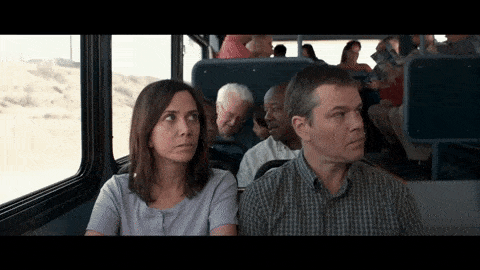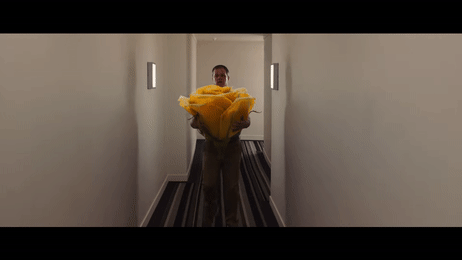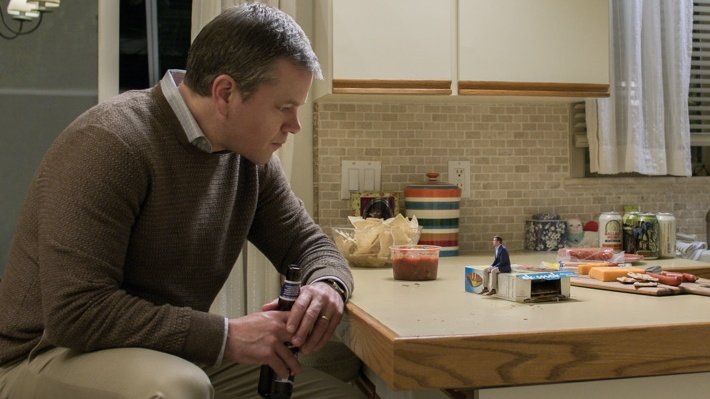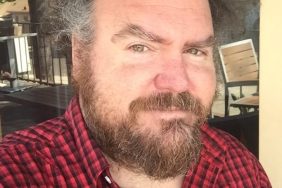Set in a world where you can shrink yourself down to about five inches tall, Downsizing is Alexander Payne’s latest cautionary tale of ordinary madness and suburban mediocrity. Having made a name for himself with such themes in his films Election, Sideways, The Descendants, Nebraska and others, Payne has decided to expand his vision with this film, paradoxically shrinking his characters to do so and boldly venturing into the world of science fiction.
Touching on everything from environmentalism to the contemporary obsession with self-improvement and personal development, Payne has a lot to say in the film. Other than his being tiny, main character Paul Safranek (Matt Damon) may seem like yet another Payne-sian everyman coming to grips with the fact he is simply unremarkable. Unlike his other protagonists however, this character is more externally focused, with the director using Small Paul to examine larger ideas and having plenty of fun along the way.
With that in mind we thought now would be a great time to walk through the big, and not so big, ideas in the small world that is Downsizing.
1.One Size Fits All Your Problems
The idea that there is one solution to all of life’s problems — or rather a critique of this idea — is built into the very premise of the film. As Payne and his characters initially tell/sell us, “getting small” as they call it, isn’t just a solution to the climate change and the environmental crisis, it’s also a ‘one size fits all’ solution to all of life’s problems. Struggling to make ends meet? Tired of the routine of everyday life? Want more time to pursue your passions? Getting small promises to solve all of these problems and more, especially if you move to one of the purpose-built pleasure enclaves like Leisureland. The only problem is that for Paul, getting small doesn’t solve his problems, it just adds to them.
Payne uses the procedure as a sort of catch-all to critique our culture’s obsession with self development and improvement. Whether it be shrinking yourself down to five inches tall, or going on an extended yoga retreat or sustainability workshop, Payne suggests that whatever you change externally, the real change has to come internally through self acceptance if you actually hope to improve your life. Otherwise you’ll just wind up stuck in a different place with different people, but all of the same problems.
2. What About Insects and Other Creepy Crawlies?
Now this is one of those not-so-big ideas raised by the film, but to any Honey, I Shrunk The Kids fans like me, the first question you’re likely to ask about the films is: does anyone get eaten by a ‘relatively’ giant insect? The film explains that the downsized colonies like Leisureland are protected from life-sized animals and insects by domes, which also protect the smalls from UV radiation, to which they are particularly vulnerable. But as we find out later, not all the residents of Leisureland live inside the dome… begging the question: what happens when an animal attacks? Aside from that, surely the domes must need defending as well, or at least maintenance, right? And what happens if one fails? Is there an emergency strike force of smalls? Do the bigs help out?
So many questions. Here’s hoping that — what with Hollywood’s obsession with franchises, sequels and shared universes — we get a sequel/spin off focusing on this aspect of the world in the not too near future… Downsizing 2: Big Trouble, Little People. Anyone?
3. The Emptiness Of Materialism
One of the big selling points of the process of getting small in the film is of course that your money goes a lot further when you are tiny. Specifically, about 82 times further. But as we start to explore the downsized world, the life of plenty and indulgence that was promised is shown to be rather empty. While ageing party boys Dušan and Joris — played wonderfully by Christoph Waltz and Udo Kier — do provide some of the film’s most enjoyable moments, they are only moments. By the end of the film, Payne has made it clear that the kind of life the two characters represent is as empty as the rest of the world is fast becoming, as downsizing becomes more and more popular. Instead, Paul finds meaning elsewhere in Leisureland, but more on that soon.
4. Tell Me More About The Black Market
Speaking of Dušan, he is not only one of the most enjoyable parts of the film – even if we are meant to learn from his example rather than emulate it – but also one of the most intriguing. Funding his ‘party boy’ lifestyle by buying life-sized luxury items and then dividing them up to be resold onto his fellow ‘smalls’ on the black market at a not-so-small mark up, I couldn’t help but ask myself what else Dušan and his fellow black marketeers might traffic in. While we see him selling Cuban cigars and other goods, as one might predict, they don’t leave the good stuff out on display for anyone to see. You have to know where to go, who to ask, and what to ask for. Unfortunately, the film moves on rather quickly after tipping its toe into the nefarious world of the black market, but this could again serve as a great chance for future films to fully explore the depths of this murky part of the world of the smalls. Downsized 3: Streets Of Vice. Anyone?
5. Not All The Smalls Live The Same Sized Life
While downsizing promises a life of luxury for some, for others it is more like a prison sentence. Literally, in the case of Ngoc Lan Tran (Hong Chau), who — after being discovered illegally attempting to enter the United States — is downsized against her will as punishment. Just in case this wasn’t bad enough, she also had her leg amputated in her efforts to enter the country, and now must struggle with a misfitting prosthetic as she works as a cleaner for the Dušan and his ilk. Ngoc isn’t the only one (as Paul discovers after befriending her) but is just one of the small army of migrant workers who live on the fringes of Leisureland, outside the dome, and therefore under the threat of attack from animals and the ravages of radiation. Yet, as you may expect from Payne, it is in this world that Paul begins to find the meaning he was lacking previously, but again, more on that soon.

6. Self Sacrifice vs Self Preservation
One of the central questions posed by the film is whether it is better to sacrifice for others, or to just focus on yourself. While this does play out through the character of Paul and his journey towards self acceptance and finding happiness, the dual motivations for ‘getting small’ brilliantly foreshadows this tension. Initially designed as a means of saving the environment, the procedure is quickly commodified and sold to potential clients as a kind of luxury retirement plan.
However, as we soon discover, ‘getting small’ to stretch your dollar or spice up your boring life, doesn’t always have the intended outcome, with Paul finding himself struggling just as much — and even more alone — after getting small. Where he does find salvation, though, is in helping others. This realisation, while simplistic, perfectly encapsulates the film’s message that life is lived with others, and not behind protective closed doors.

—












